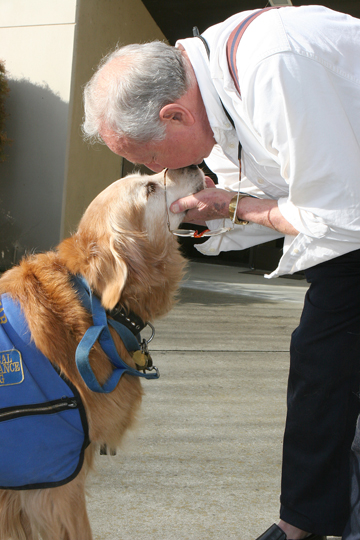
Dogs help diabetics stay healthy
Dogs. Big or small, shaggy or short-haired, they greet us with a
wag of the tail after a long day at work as though we’ve been gone
forever. They have been called man’s best friend with good reason.
Some of us, such as the Truskowski family are willing to do
anything to keep our pets with us
– even proffering up shots of insulin to the family dog.
But in some cases dogs are doing just as much to help their
owners as some owners do for their pets.
Dogs help diabetics stay healthy
Dogs. Big or small, shaggy or short-haired, they greet us with a wag of the tail after a long day at work as though we’ve been gone forever. They have been called man’s best friend with good reason. Some of us, such as the Truskowski family are willing to do anything to keep our pets with us – even proffering up shots of insulin to the family dog.
But in some cases dogs are doing just as much to help their owners as some owners do for their pets.
Some dogs, such as Bear, a burly golden retriever, does a lot more than keep his owner Bob Mohlenhoff company. Mohlenhoff, who lives in Monterey, but works in Hollister, has diabetes and relies on insulin to control his blood sugar levels. When his sugar level dips too low, Mohlenhoff blacks out and falls down.
“I had a big problem,” Mohlenhoff said. “I was going to be laid off – put on disability – because I was a danger to myself and others.”
As a diabetic most of his life, Mohlenhoff wasn’t sure what to do until a friend suggested he have his dog Bear trained to notify him when his sugar level was about to drop. Mohlenhoff had Bear since he was just a puppy of six weeks and though the two had gone to obedience training, Mohlenhoff wasn’t sure how his dog could help him.
Through research, Mohlenhoff found a dog trainer in Paso Robles who trained service dogs to help people with epilepsy. She agreed to train Bear to detect when his owner’s blood sugar changed to a dangerous level. With their keen canine sense of smell, dogs can smell change in people’s blood chemistry – including when the blood levels of diabetics are too high or too low.
Around the same time that Mohlenhoff found his trainer in Paso Robles, a group in Concord started research on training dogs to help diabetics.
Dogs4Diabetics trains 10 dogs a year for insulin-dependent diabetics who have a history of problems with extreme lows in their blood sugar.
“Our dogs are specifically trained to alert someone at the beginning of a blood sugar drop,” said Carol Edwards, the program director for Dogs4Diabetics. “It’s similar to bomb or narcotic work.”
Through games of hide and go seek, the dogs learn to find the scent of low blood sugar in exchange for a reward. Later, they are trained to alert their owners when they smell the same scent.
The group mostly works with Labrador retrievers and gets many of their dogs with some socialization and training from a guide dog group in Santa Rosa. They work for eight to nine months with the dog and when they have picked a placement for the dogs, the owner-to-be will work with them for four to six months.
Using some of Bear’s normal behaviors, such as a demanding “errrrrrhhh” he made whenever Mohlenhoff forgot to feed him, the trainer taught Bear to make that noise when he smelled a dip in blood sugar of his owner.
“I worked with [the trainer] for four months and the end result is that Bear can do two things,” Mohlenhoff said.
One thing Bear does is lick Mohlenhoff’s hands or bark if he passes out to get him up or he goes to someone else to get help for his owner.
“Most importantly, before I pass out – he does this by smell – he realizes I am in distress and he gets up in my face and goes nose to nose and goes ‘errrrrrhhhh, errrrrrrhhhh, errrrrrrrhhhh.'”
Bear only acts that way when he knows his owner needs to take glucose quickly, and Bear even wears a vest with a pouch for Mohlenhoff’s glucose pills.
“I’ve trained myself to take glucose out of my pocket or out of his vest,” Mohlenhoff said. “I take it and six minutes later I am fine.”
The dogs from Dogs4Diabetics are trained to notify their owners at the start of a blood sugar drop.
“They alert before blood sugar gets low,” Edwards said. “The person shouldn’t be symptomatic so they can get up and get an apple juice or something.”
The dogs are trained to notify owners when their blood sugar hits 70 – the minimum level most doctors point to as safe – though the trainers will adjust this if there is a higher level that is best for the owner.
Mohlenhoff has been able to keep a job thanks to help from Bear, who even flies beside his owner when they travel. The two even volunteer at a Monterey hospital, where Bear is a therapy dog. The only place Bear doesn’t go is church.
“I don’t take him to church because he snorts when he sleeps.”
For diabetics who are interested in learning more about training a dog, Mohlenhoff can be reached at bm*********@**********es.org or at 831-393-1575, or visit the Dogs4Diabetics Web site at www.dogs4diabetics.com.









